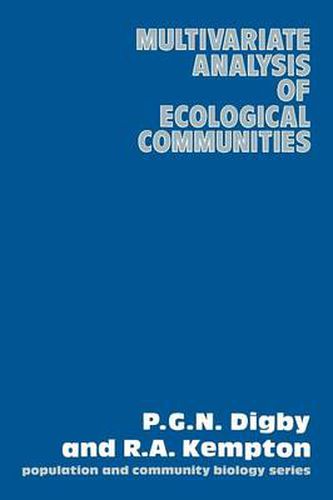Readings Newsletter
Become a Readings Member to make your shopping experience even easier.
Sign in or sign up for free!
You’re not far away from qualifying for FREE standard shipping within Australia
You’ve qualified for FREE standard shipping within Australia
The cart is loading…






This title is printed to order. This book may have been self-published. If so, we cannot guarantee the quality of the content. In the main most books will have gone through the editing process however some may not. We therefore suggest that you be aware of this before ordering this book. If in doubt check either the author or publisher’s details as we are unable to accept any returns unless they are faulty. Please contact us if you have any questions.
The last ten years have seen an enormous increase in the development and application of multivariate methods in ecology; indeed the perceived importance of these methods for elucidating the complex interactions observed in community studies is shown by the number of recent books devoted to introducing the more common multivariate techniques to ecologists (Williams, 1976; Orloci, 1978; Whittaker, 1978a, b; Gauch, 1982; Legendre and Legendre, 1983; Pielou, 1984) and by the chapters added to new editions of more general texts on quantitative ecology (e.g. Greig-Smith, 1983; Kershaw and Looney, 1985). Two reasons can be put forward to explain this development. The first is undoubtedly the increasing availability of cheap computing power which makes it feasible to analyse the large data matrices involved in community studies. The second, perhaps less widely appreciated, is the change in emphasis of theoretical work on multivariate analysis, away from the development of formal statistical models and associated distribution theory towards descrip tive techniques for exploring pattern in data sets and providing succinct summaries and displays. This new approach, termed ‘pattern analysis’ by Williams (1976), has led to a range of statistical techniques which have been enthusiastically taken up by ecologists to replace the collection of ad hoc procedures developed over the years for analysing community data.
$9.00 standard shipping within Australia
FREE standard shipping within Australia for orders over $100.00
Express & International shipping calculated at checkout
This title is printed to order. This book may have been self-published. If so, we cannot guarantee the quality of the content. In the main most books will have gone through the editing process however some may not. We therefore suggest that you be aware of this before ordering this book. If in doubt check either the author or publisher’s details as we are unable to accept any returns unless they are faulty. Please contact us if you have any questions.
The last ten years have seen an enormous increase in the development and application of multivariate methods in ecology; indeed the perceived importance of these methods for elucidating the complex interactions observed in community studies is shown by the number of recent books devoted to introducing the more common multivariate techniques to ecologists (Williams, 1976; Orloci, 1978; Whittaker, 1978a, b; Gauch, 1982; Legendre and Legendre, 1983; Pielou, 1984) and by the chapters added to new editions of more general texts on quantitative ecology (e.g. Greig-Smith, 1983; Kershaw and Looney, 1985). Two reasons can be put forward to explain this development. The first is undoubtedly the increasing availability of cheap computing power which makes it feasible to analyse the large data matrices involved in community studies. The second, perhaps less widely appreciated, is the change in emphasis of theoretical work on multivariate analysis, away from the development of formal statistical models and associated distribution theory towards descrip tive techniques for exploring pattern in data sets and providing succinct summaries and displays. This new approach, termed ‘pattern analysis’ by Williams (1976), has led to a range of statistical techniques which have been enthusiastically taken up by ecologists to replace the collection of ad hoc procedures developed over the years for analysing community data.